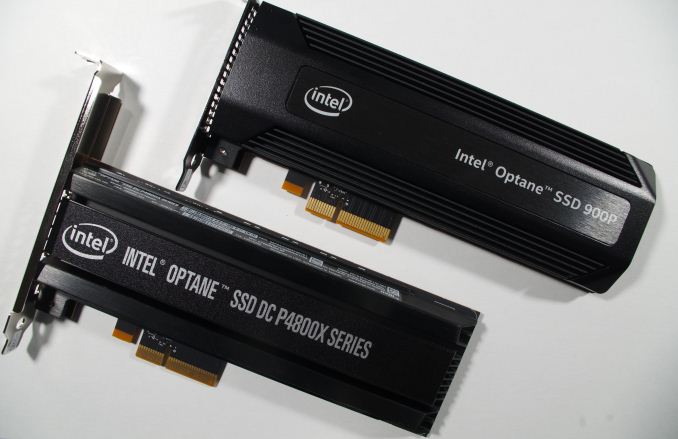Intel Optane SSD DC P4800X 750GB Hands-On Review
by Billy Tallis on November 9, 2017 12:00 PM ESTConclusion
There aren't really any surprises to this review. As promised, the Intel Optane SSD DC P4800X 750GB performs about the same as the 375GB model we tested earlier this year, which puts it far above the flash-based competition. The doubling of the drive's capacity has brought it up to a far more usable level where it can more easily be regarded as either an expansion of memory or as a reasonably large storage device that is extremely fast.
The Optane SSD DC P4800X is not a one size fits all enterprise SSD, but for certain use cases it has almost no competition. SSDs using SLC NAND once offered latency close to the Optane SSD, but their high prices made them a niche product that most manufacturers decided wasn't viable. 3D XPoint memory is significantly more expensive than current 3D MLC and 3D TLC NAND flash memory, but the low latency and high performance consistency it enables have a place in today's enterprise SSD market.
Testing the ostensibly consumer-oriented Optane SSD 900p in the context of enterprise storage reveals the 900p to be just as competent in the performance department. There are several enterprise-class features missing from the 900p, most notably support for different sector sizes with protection metadata. Support for out of band management and is more of a convenience than a necessity except in large scale cloud hosting deployments. The missing enterprise features are not a showstopper for every enterprise customer. Otherwise, the 900p is roughly the P4800X in different capacities with a lower write endurance rating and a proportionally lower price. The 900p is essentially an entry-level Optane enterprise SSD, with a value proposition that is at least as attractive as the Optane P4800X.











58 Comments
View All Comments
AlaskanDruid - Thursday, November 9, 2017 - link
Ok. what am I missing? What is the use of these when you can have one in a m.2 form which takes up MUCH less room?I know I'm missing something, but what is it?
Drumsticks - Thursday, November 9, 2017 - link
The drives dissipate 12-18W, which is 2-3x more than flash based SSDs. I don't think the m.2 form factor would make heat dissipation easy, unless you scale the design back down to the 32-120GB range.Billy Tallis - Thursday, November 9, 2017 - link
More than just capacity, you'd almost certainly have to scale down performance by a lot. It's possible to do better than the current PCIe x2 32GB module, but a 7 channel controller would be hard to fit physically, and it would have to run slower to not melt. I think a ~3 channel M.2 drive is plausible, but I'm not sure its write speeds would be high enough.DanNeely - Thursday, November 9, 2017 - link
it looks like you could physically do 7 (or even 8) channels on a dual sided 22110 m.2 module with the current package size. The thermals would be a real challenge though; and are why I really wish U.2 would've gained at least a little traction in the consumer market.Billy Tallis - Thursday, November 9, 2017 - link
I was thinking more along the lines of a 22x80mm card. I agree that 7 3D XPoint packages is probably possible on 22x110, but I'm not sure how dense the controller's BGA pad can get.DanNeely - Thursday, November 9, 2017 - link
If you went 2 sided you could fit 6 on a 2280 card. With a bare bottom they're just short on enough room for a 3rd package on top; move some of that misc stuff underneath and you'd free up the PCB area needed.Rwbeckman - Thursday, November 9, 2017 - link
This is the datacenter model, good for releasing higher capacity sooner with its size. Plus rackmount cooling design will help. U.2. Will be for hot swap, the card will not. The M.2 enthusiast consumer model is the 900PSamus - Thursday, November 9, 2017 - link
XPoint technology is just one of the reasons Intel released the "ruler" form factor for future SSD's. I suspect a mobile variant will replace m2 in the future.https://www.anandtech.com/show/11702/intel-introdu...
CheapSushi - Thursday, November 9, 2017 - link
Or just use the new M.3 format (wider) that Samsung came out with.Drumsticks - Thursday, November 9, 2017 - link
Great review Billy, thank you!Optane as a gen 1 product is pretty fantastic. I can't wait to see how the rest of the market will compete, and what Intel and Micron (where are their drives?) can do for round two.